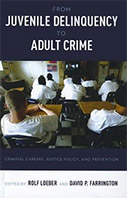From Juvenile Delinquency to Adult Crime: Criminal Careers, Justice Policy and Prevention
 Editors: Rolf Loeber and David P. Farrington
Editors: Rolf Loeber and David P. Farrington
Publisher: New York: Oxford University Press, 2012. 416p.
Reviewer: Christopher J. Sullivan | July 2013
In presenting her theory of adolescence-limited offenders, Terrie Moffitt (1993) pointed toward broad shifts in the way that youths come of age in Western nations as one explanatory factor for the shape of the age trend in criminal behavior. Several years later, Jeffrey Arnett (2000) suggested that more recent shifts, such as later age of marriage and increased college attendance leading to later entry into the work force, contribute to an elongated developmental stage between adolescence and full assumption of adult responsibilities. He termed this “Emerging Adulthood” and the volume developed by Rolf Loeber and David Farrington, From Juvenile Delinquency to Adult Crime, focuses on this segment of the life course as pertains to criminal behavior and society’s response to it. The same general crime trends used as a starting point by Moffitt suggest that understanding and responding to criminal behavior during the transition to adulthood may be a linchpin in crime prevention and control more generally as that is the point at which desistance or persistence in offending over the longer life course comes into view.
The volume contains works focused on defining the key characteristics of the late adolescence/early adulthood portion of the criminal career (Piquero, Hawkins, and Kazemian), explaining persistence and desistance in offending during that period (Horney, Tolan, and Weisburd; Thornberry, Giordano, Uggen, Matsuda, Masten, Bulten, and Donker; Rosenfeld, White, and Esbensen), and the response in the U.S. (Hoge, Vincent, and Guy; Griffin; Howell, Feld, and Mears; Welsh, Lipsey, Rivara, Hawkins, Aos, and Hollis-Peel) and Europe (Killias, Redondo, and Sarnecki). Together, the editors and chapter authors look at crime in this developmental period from a number of angles, ranging from a description of the problem to research on risk assessment and prediction, justice response, prevention, and wide-reaching prescriptions for policy and practice.
Early chapters of the book focus on defining some important criminal career patterns relevant to the discussion and subsequently reviewing explanations for continuity or desistance in offending during the transition to adulthood. Piquero, Hawkins, and Kazemian begin by defining pertinent aspects of criminal career research that set the stage for consideration of the causes, consequences, and response to offending in emerging adulthood. Among the important findings is the degree of continuity in offending from adolescence to early adulthood without appropriate response—particularly for delinquents with more extensive records. Thornberry and colleagues (Chapter 3) then provide a detailed overview of the theoretical perspectives relevant to this question—covering a broad swath of possible explanations for continuity or desistance during this time period in the process (e.g., static models based on enduring differences, dynamic explanations that encompass changes in social situations over time, an integrated framework from developmental psychopathology). In the next chapter, Horney, Tolan, and Weisburd focus on potential contextual influences that are likely to emerge during this phase of development. At that point, individuals may be trying to find places to live, rebuild or maintain relationships with family and friends, and develop occupational skills through training and schooling in order to facilitate a transition to normative adult roles; the result of that process has implications for whether they continue with criminal behavior or take a path more conducive to a prosocial lifestyle. This chapter demonstrates the importance of the social system and opportunities that youth encounter as they approach adulthood, as they may have considerable influence on their criminal behavior. In Chapter 5, Rosenfeld, White, and Esbensen look at special categories of offenders such as drug dealers, gang members, and homicide offenders during this period of development. They conclude that, for the most part, knowledge that comes from general studies of offenders pertains to these special groups in that they tend to follow a lot of the same offending career patterns as those identified in other samples. Drug dealing was found to have greater persistence than other offense types, however.
The last several chapters of the book take on practical aspects of responding to offending during (and before) emerging adulthood. If understanding offending in emerging adulthood is predicated on getting a read on the explanatory mechanisms presented by Thornberry and colleagues and Horney and colleagues, the response must draw on assessment and prediction that occurs within the juvenile justice system and related agencies. The chapter by Hoge, Vincent, and Guy reviews the relevant literature in this area and also presents some new analysis of three assessment tools to consider the viability of this practice. Despite the limitations of the literature in this area and risk/needs assessment more generally, the authors reach some important conclusions about core domains that should be included in practical tools (e.g., impulsivity, callousness) and point out that emerging adulthood may be unique in some ways that must be thoughtfully considered in the assessment process and use of results (especially those from other developmental stages). Additionally, they point out that, although there is a lot of continuity, the chances of persistence even among more serious offenders is fairly uncertain, so prediction of behavior across periods can be difficult.
After Griffin provides an overview of how different states have established the border of juvenile and adult status in terms of transfer policies and jurisdictional age boundaries more generally, Howell, Feld, and Mears (Chapter 8) and Welsh and colleagues (Chapter 9) present a comprehensive review of the way that juvenile and criminal justice systems respond to these youth and prevention programs that might be directed at the problem, respectively. While both groups report limitations in the knowledge base on intervention, they do identify areas where researchers, policymakers, and practitioners might place their attention with regard to evidence-based practices. For example, the population of interest in From Juvenile Delinquency to Adult Crime will likely have had prior contact with the juvenile justice system, which means that interventions and correctional programming in that sector of justice activities may be especially important in determining whether this antisocial behavior continues or is curtailed following adolescence. Further research and program development should also consider the re-entry challenges for serious youthful offenders during that developmental period (Chung. Little, & Steinberg, 2005) as a means of determining how the line from delinquent to criminal careers might best be broken. Following the consideration of what is done with respect to this population in the U.S., Killias, Redondo, and Sarnecki offer some insights into European policies. They find a good deal of variety in the approaches taken in their sample of countries, some of them similar and some markedly different from those identified in other chapters in the volume.
Summarizing the information from the various reviews of what is known about this subject, Loeber, Farrington, Howell, and Hoeve make a number of recommendations for policy and practice in the concluding chapter, including some that have received scant attention in previous work and others that draw on the comparative research done by Killias et al. In particular, they indicate that the way in which the U.S. justice system currently deals with offenders during the transition to adulthood does not fully comport with the evidence on the development of faculties that typically influence criminal behavior. For example, social and emotional development continues through adolescence and early adulthood, which does not fit nicely with the hard cutoffs that are often made in criminal statutes. These insights are essential in thinking about how we respond to this population, but, as is noted in U.S. Supreme Court Justice Kennedy’s majority opinion in Roper v. Simmons (2005), it is necessary to draw some line and age 18 is one that is typically used in establishing boundaries between juveniles and adults. Consequently, some policy recommendations, particularly those related to legislative changes, may be scientifically sound but policy making will be subject to other influences as well, which makes the prospects for some of the recommendations difficult to gauge (Cauffman, 2012). Advocates and concerned policymakers have only recently had success in moving age cutoffs for adult court jurisdiction upward (Justice Policy Institute, 2013; Illinois Juvenile Justice Commission, 2013), so movement toward discounting sanctions and providing specialized response to those beyond age 18 may not gain a foothold in the near future. Those points notwithstanding, other recommendations, such as providing greater reentry support and enhanced treatment options for this population, are likely to garner more support from legislators and advocacy groups and may in fact be more important in preventing long-term offending and maximizing the life chances for those in emerging adulthood (Cauffman, 2012).
Moffitt’s adolescence-limited framework was recently used as metaphor to critique the sometimes-stunted development of knowledge in criminology (Cullen, 2011). From Juvenile Delinquency to Adult Crime offers an expansive, definitive compilation of what is known about a key period of the life course as it pertains to criminal behavior. Much of the existing literature relies on findings from earlier or later developmental periods, so, almost of necessity, the book tends to raise many new questions even as it provides preliminary answers to those that it takes up. In that sense, Loeber and Farrington and the chapter authors have established a detailed roadmap for advancing understanding of an important portion of the offender population, one that is likely to contribute to efforts that materially affect serious, violent and chronic criminal career patterns. This work offers an initial foray into a topic of great import that has not received much attention to this point. Both literally and figuratively, this volume moves beyond adolescence-limited criminology.
References
Arnett, J. (2000). Emerging adulthood: A theory of development from the late teens through the twenties. American Psychologist, 55, 469-480.
Cauffman, E. (2012). Aligning justice system processing with developmental science. Criminology & Public Policy, 11, 751-758.
Chung, H., Little, M., & Steinberg, L. (2005). The transition to adulthood for adolescents in the
juvenile justice system: A developmental perspective. In Osgood, D.W., Foster, E.M.,
Flanagan, C., & Ruth, G.R. (Eds.), On Your Own Without a Net: The Transition to Adulthood for Vulnerable Populations. Chicago, IL: University of Chicago Press.
Cullen, F.T. (2011). Beyond Adolescence-Limited Criminology: Choosing Our Future—The American Society Of Criminology 2010 Sutherland Address. Criminology, 49, 287-330.
Illinois Juvenile Justice Commission (2013). Raising the Age of Juvenile Court Jurisdiction: The Future of 17-Year-Olds in Illinois’ Justice System.Springfield, IL: Illinois Juvenile Justice Commission.
Justice Policy Institute (2013).Juvenile Justice Reform in Connecticut: How Collaboration and Commitment Have Improved Public Safety and Outcomes for Youth.Washington, D.C.: Justice Policy Institute.
Moffitt, T. E.(1993). Life-course-persistent and adolescence-limited antisocial behavior: A developmental taxonomy. Psychological Review, 100, 674-701.
Roper v. Simmons, 541 U.S. 1040 (2005).
—
Christopher J. Sullivan is an Associate Professor in the School of Criminal Justice at the University of Cincinnati


